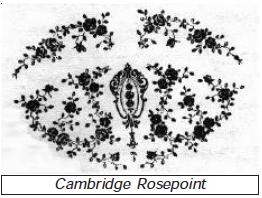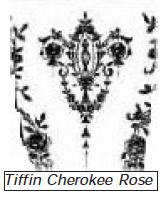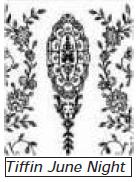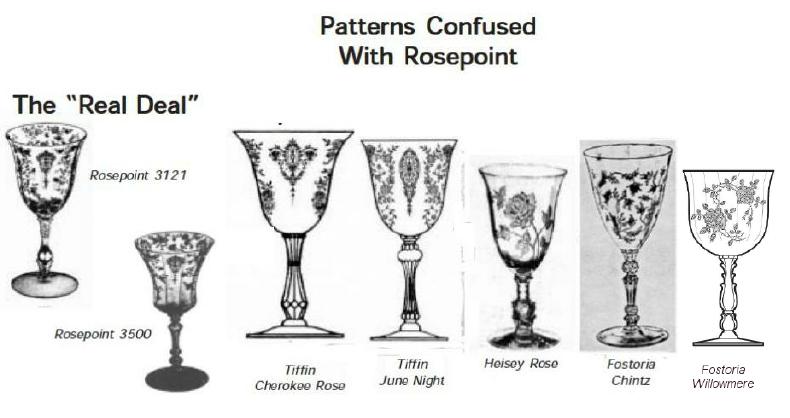Similarities Cause Confusion For Beginning Collectors
by David Adams
Issue No. 390 - November 2005
One of the things that I learned from the late Frank Fenton was that the various glass companies tended to watch each other very carefully to see what the "other guy" was doing and which items were successful. When they saw a trend that looked promising, they tended to copy one another as closely as they could without infringing upon any patents.
Frank had an "idea room" at the Fenton factory, where he kept pieces of glass that were made by companies other than Fenton. They were pieces that he admired for one reason or another. Every once in a while he would bring one of the pieces to his mold shop and ask that the shop make a mold for a piece that was similar, but with a few changes here and there. Frank might have them modify the way the top was shaped, or add a foot, or even remove a foot. He might choose a pitcher and tell the mold shop to create a vase in a similar shape, but with ruffled top. In short, he used other designs to inspire him to create Fenton pieces.
There's nothing wrong with imitation: in fact there's the saying that "imitation is the sincerest form of flattery." So, through the years, glass companies tended to imitate the successes (and sometimes the failures) of each other. For example, Fenton introduced the process which iridizes glassware and very shortly thereafter a number of companies followed suit, creating what we now call "Carnival Glass." Northwood, Millersburg (owned by another Fenton brother), Imperial and Cambridge all followed with their own iridized glass, and for a number of years that was the "hot" item. When the American public finally tired of the iridized glass and became more interested in colored glassware, the glass companies were stuck with rather large inventories of the iridized glass, and eventually sold it for what they could get. Large quantities wound up in the possession of Carnival troupes and the glass was given as prizes in the "Carny" games. Toss a nickel and if it lands on a piece of glass, the glass is yours to keep.
 Cambridge introduced the Rosepoint pattern (shown at left) in late 1934 and it was produced continually until the factory closed for good in 1958. After Imperial purchased the assets of the Cambridge Glass Company, they produced a number of pieces in Rosepoint and labeled them (on paper labels) "Cambridge by Imperial". Rosepoint was Cambridge's best selling etched pattern, so one might suspect that the tendency of the other glass companies would be to try to imitate Cambridge's success. Sure enough, there are two patterns that closely resemble Rosepoint and these patterns are often mistaken for Rosepoint, particularly by eBay sellers (who tend to be, for the most part, singularly uninformed about glassware).
Cambridge introduced the Rosepoint pattern (shown at left) in late 1934 and it was produced continually until the factory closed for good in 1958. After Imperial purchased the assets of the Cambridge Glass Company, they produced a number of pieces in Rosepoint and labeled them (on paper labels) "Cambridge by Imperial". Rosepoint was Cambridge's best selling etched pattern, so one might suspect that the tendency of the other glass companies would be to try to imitate Cambridge's success. Sure enough, there are two patterns that closely resemble Rosepoint and these patterns are often mistaken for Rosepoint, particularly by eBay sellers (who tend to be, for the most part, singularly uninformed about glassware).
 The first of these patterns is Cherokee Rose (illustrated at right), manufactured by Tiffin Glass Company of Tiffin, Ohio. Tiffin was also known as "Factory R" of the United States Glass Company, and they may have been the largest American manufacturer of blown stemware, even larger than Fostoria. The Cherokee Rose pattern is shown above right.
The first of these patterns is Cherokee Rose (illustrated at right), manufactured by Tiffin Glass Company of Tiffin, Ohio. Tiffin was also known as "Factory R" of the United States Glass Company, and they may have been the largest American manufacturer of blown stemware, even larger than Fostoria. The Cherokee Rose pattern is shown above right.
The pattern contains a "cameo" which in itself contains an urn, or what appears to be an urn. There are sprigs of flowers to the sides of the cameo. This is very similar to the Rose Point pattern, except that Rose Point has three roses inside the cameo. Upon close inspection, there are other differences, but the contents of the cameo are the most easily recognized.
Tiffin made a second pattern which is also often confused with Rose Point. That pattern is called June Night, shown below, left. This one also has a cameo and the cameo contains a flower. But the shape of the cameo (or medallion) is quite different from that of Rose Point or Cherokee Rose and there should be little trouble differentiating this from either of the other
 two. Nevertheless, beginning collectors seem to have difficulty.
two. Nevertheless, beginning collectors seem to have difficulty.
There are other "rose" patterns that I've seen identified as Rose Point by eBay sellers, but these should prove to be no problem, even for the very novice collector of Rose Point. The patterns include Fostoria's "Chintz" and "Willowmere" (a pattern which is also sometimes identified as "Heisey Rose"). At the end of this article, you will find drawings of the goblets in each of the patterns mentioned above.
Note that Rosepoint was offered on several different stemware lines, but the 3121 shape shown in the drawing is the one which most closely resembles June Night and Cherokee Rose stemware. This whole article boils down to one simple fact, preached over and over in the pages of the Crystal Ball: "Collectors: know your pattern. Education is the best protection you have." NCC has a wealth of publications related to Cambridge glass, and you should take advantage of the knowledge that those publications provide.
I'd like to end the article where I started, with Frank Fenton. He related another story regarding the tendency of glass companies to copy one another. In the 1950's, Fenton had introduced a "blue milk glass" color which was not selling very well. Frank got a call from his counterpart at Fostoria Glass Company and was asked how the newly introduced "blue milk glass" was selling. Of course, Frank told them (with a straight face) that it was selling like hotcakes. Sure enough, Fostoria began producing items in "blue milk glass". They sold just about as well as Fenton's – not well at all.
The glass world lost a gem when Frank passed away this summer. His knowledge and his willingness to share were legendary. If you met Frank once, he was your friend forever. His kind shall not pass this way again.

